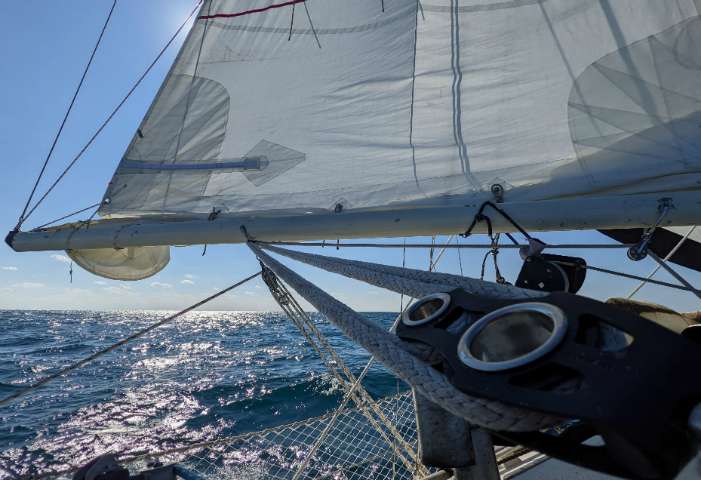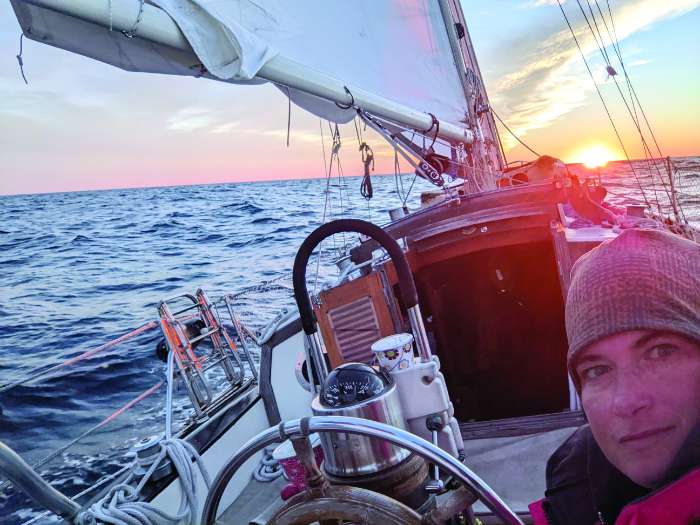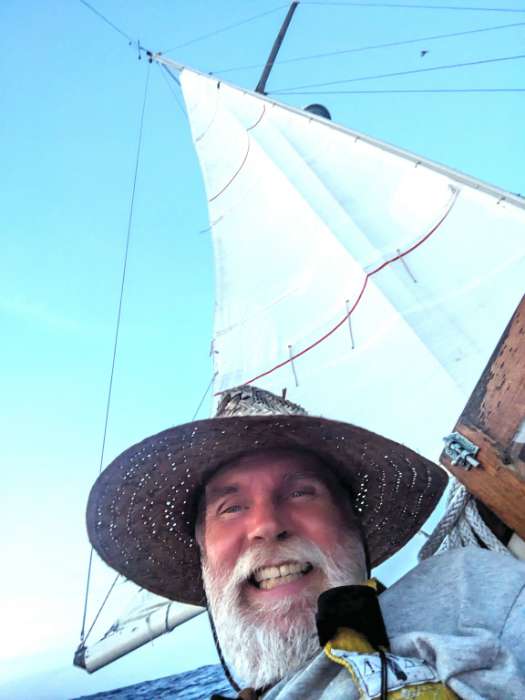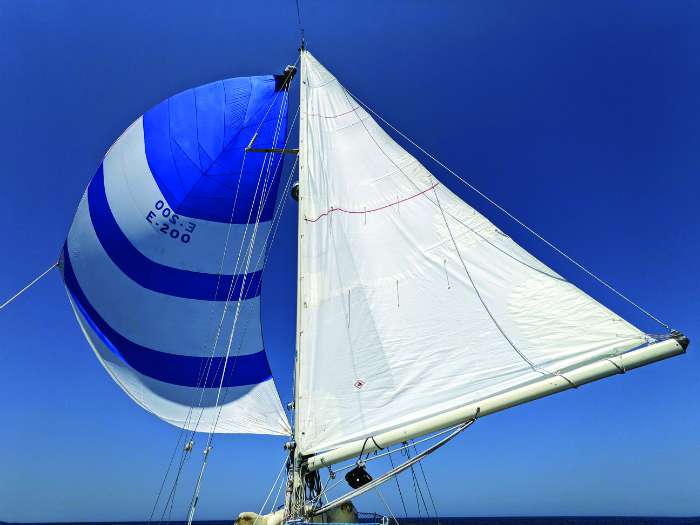Fair Winds… and What?! Why Following Seas Aren’t Always Best for Sailors
When I was growing up in a south Texas boatyard in the late 1970s, scraping and sanding on my father’s seven-year schooner project, I watched a lot of adventuring cruising sailors come and go. Corpus Christi is a busy jump-off point for Gulf Intracoastal Waterway (GIWW) sailors and Caribbean adventurers. When a sailor departed on a true adventure from our marina, you’d hear one particular phrase echoed over and over, and that was: “Fair winds, my friends!”

Many years later, when my partner and I bought our first boat on the west coast of the United States, I started hearing what I thought was a bastardization of that once peaceful wish with a different second phrase that went… “And following seas!”
Somehow the friendship aspect of that salty old send-off had disappeared between Texas and Seattle and was replaced by, of all things, following seas. I went to the official U.S. Navy website to try to find an origin story behind the famous old adage, and even the Navy tells us there is no known origin to “Fair Winds and Following Seas.” I wonder why would a person wish that on anybody?
Our first taste of it
Those words were uttered by the broker when we bought our first cruising sailboat. About a month later, we got a true taste of the intense power of a following sea.
The Saratoga Passage between Whidbey Island and Camano Island in Washington State is the very definition of troubled waters, driven by some truly awesome currents. On the Whidbey side, there are some spectacular anchorages that shouldn’t be missed on any adventure to the San Juan Islands from Seattle, so we put the hook down just south of Randall Point at 10-to-one in 10 feet of water on an eight-foot rising tide and whipped up some truly delectable trash hash (mac-n-cheese with canned tuna mixed in).
This was very early in the whole cellphone thing, so connectivity was iffy at best in the more remote places of the Puget Sound, and it was easy to get away from distractions. Regardless of our desire for privacy, we got a call from a friend in the middle of the night telling us to get to some protection quickly because the next day was going to be hell.
We tuned in to NOAA weather radio. Sure enough, Perfect Paul promised us 60 knots of westerly wind by noon. Our trusty barometer had already taken a serious dive. In our great big (new to us) wooden Seawolf ketch, we figured we could still get a good night’s rest, get underway before the sun came up, and beat the storm to Oak Harbor at the protected north end of the Passage.
We left on glass at 6 a.m. By 9 a.m., we were double-reefed on a broad reach with the main only and still way over-powered. We fought a foul outgoing tide for most of the morning. The seas stacked up from behind like nothing either one of us had ever seen. I’m talking about sharp, pointy, monster growlers that were coming to get us from astern. How big? Who cares!

Those foretold following seas that the broker had wished upon us were so much meaner and bigger than we or our freaked-out cat could imagine prior to that day. After the turn around they only got bigger and angrier, but we made it into Oak Harbor without breaking anything.
The local TV news station came out to cover the storm and caught us on camera navigating the marina’s frightening dog-leg channel. They stuck around filming bits and pieces of tattered flags and plastic patio furniture flying away. A short while later they found us on our way out of the marina gate with all our storm-wet, salty laundry slung over our shoulders. They turned the camera on us, and when the reporter asked if we’d ever do anything crazy like that again and held the mic out my way, I got to deliver my favorite line ever to a reporter. I said, “Are you kidding me? We live for this s#*!!” I got bleeped by the locals.
Instead of making it to the San Juans that year, we lived through a historic storm and spent three days in Oak Harbor listening to the banshees in the rig, petting the cat, and doing laundry.
One of those personal heroes I never want to meet in person, Robert Perry, world-famous marine architect and the designer of the electric Baba 30 we live on now, has said to his fan club that following seas are his least favorite way to track through the water. I can’t say the same, actually. My least favorite way to sail is beating into bashing seas and headwinds. I like a nice broad reach in 10-15 with all the laundry up and the windvane at the helm.
There are better following-sea days
Don’t get me wrong, our 24 years of living underway have given us many a glorious following wave pattern, oceanic as well as in protected waters. Annapolis provided us with glorious downwind wing-on-wing runs under the Chesapeake Bay Bridge to the Swan Creek anchorage and sometimes a reciprocal downwind run home after the winds clocked around in the shoulder seasons.
Regardless, a giant, slurping, growling, angry following sea remains the most terrifying thing a sailor can endure. Once you get her settled on the waves at the best angle (of course it varies with the sea conditions and the vessel), it does no good at all to look behind you. So, why do it? Because you must. You’re a sailing masochist. You just can’t help it.
When we were coming down the west coast of the U.S. from Blaine, WA, to the San Fransisco Bay, we “broke some stuff” (as you do) and ended up wintering in Eureka, CA, for four dreary months of the grim winter of 2001/02. We both landed pretty good jobs in the Bay Area prior to moving the boat south to San Francisco, so we briefly bunked in a student boarding house in Berkeley.

Growlers stacking up behind us…
We got another one of those awful nighttime calls from a friend in Eureka to let us know that our boat had been hit at the dock by a very large brand-new power yacht. She hadn’t sunk, but her mizzen boom and rig had been badly damaged, and the solid teak aft rail and solid bronze dinghy davits were destroyed.
The owner of the offending boat left his insurance information and continued on his merry way to Oregon because he was pushing the deadline to skip out on paying California sales tax. We never met the dude. His insurance company wrote a check, and we missed a year and a half of great Bay Area sailing doing repairs. But before we could do that, we got to sail our broken 28,000-pound wooden sailboat to San Fransisco from the Humboldt Bay.
Now, we’d been reading Latitude 38 (the west coast’s nearest kin to SpinSheet) for a few years at that point and had heard all about the “waves the size of Walmarts” in many a harrowing tale. It was early spring, so we were primed for hijinks… at least that’s what we thought at the time.
We used the wind and the current for the first four hours to get us resplendently out of Humboldt Bay and gybed to a starboard haul all the way out to the red/white safe-water buoy. We then gybed again, paid her main out as broad as we could get her, and went sailing in the Pacific Ocean with a fair wind and a fine following sea. We double-reefed the main and went to only a 100-percent jib less than an hour after sunset.
The growlers stacked up behind us with screamers in the rig right around midnight. By sunrise, we were in seas in excess of 40 feet that were three miles long. Because our deck was littered with tied down broken-boat detritus and our dinghy davits were destroyed, we were obliged to tow our 1924 Herreshoff lapstrake dory and watch her get utterly obliterated, and I mean turned to splinters, by one of those waves-of-doom. It was a highly charged emotional moment… and the next wave hit.
Every eight seconds of the 10 hours between Cape Mendocino and Point Arena was consumed by another one of those, um, following seas. After Point Arena, the winds calmed to near perfection, but the seas remained scary until we got around Point Reyes and well into Drakes Bay. We made landfall in Emeryville 55 hours after leaving Eureka. We were profoundly changed by that experience.

Humbled by those seas
To this day, that was the most humbling natural event of both of our lives. It wasn’t some kind of super-storm off the California coast or anything like that; it was just us not going far enough offshore to get out from under the infamous Northern California Cape Chaos! From Cape Mendocino south to the San Fransisco Bay, there are three mighty capes and a profound offshore ridge that turn the direction of the swell for almost 100 miles out to the east. Those, along with the dramatic depth decrease from offshore, create a massive swell daily within 15 nautical miles of shore. Most of the time, if you get about 50 nautical miles west of Mendocino, you never have to see what we did. But we didn’t. I will never make that mistake again. Nowadays, when we are planning a serious offshore passage along a land mass, we instinctively count the capes and err on the side of farther offshore every time.
And I can’t help but bring those experiences into the way we sailors wish each other well. I get it. For every terrible and terrifying run, there’s a counterargument in experiences when fair winds and following seas provide the perfect sublimation of sailing. In 2016, we sailed our 1961 Rhodes Chesapeake 32 from Long Island, ME, to Winter Harbor on one seven-and-a-half-hour-long wing-on-wing dream. We sailed off the anchor from Eastern Cove after brekkie and rounded up in Schoodic Harbor just before suppah. We had nothing but fair winds and following seas for the entire adventure, and of course, the rarity of that experience is why I can remember it so well to this day.
So… “Fair winds, my friends and, please at the very least, be dubious of those following seas!”
About the Author: James Lane and Dena Hankins are circumnavigating the planet Earth on a 30-foot electric sailboat. Find them at sovereignnations.net and patreon.com/user?u=92510289.




